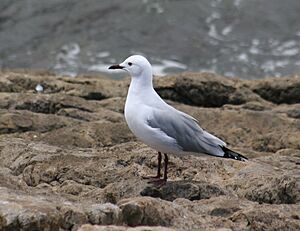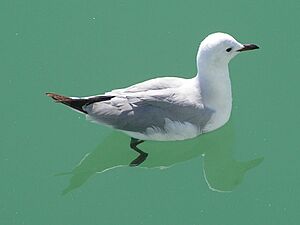Hartlaub's gull facts for kids
Quick facts for kids Hartlaub's gull |
|
|---|---|
 |
|
| Conservation status | |
| Scientific classification | |
| Genus: |
Chroicocephalus
|
| Species: |
hartlaubii
|
| Synonyms | |
|
Larus hartlaubii |
|
The Hartlaub's gull (Chroicocephalus hartlaubii) is a small type of gull. It is also known as the king gull. This bird was once thought to be a type of silver gull. Like many gulls, it used to be placed in the Larus group. Now, scientists place it in the Chroicocephalus group. The gull is named after Gustav Hartlaub. He was a German doctor and zoologist.
Contents
What Does Hartlaub's Gull Look Like?
Hartlaub's gulls are about 36 to 38 centimeters long. They are mostly white birds. Their backs and upper wings are grey. The tips of their wings are black. These black tips have clear white spots, like "mirrors." Their bills and legs are a dark red color.
When these gulls are breeding, their heads get a very light grey color. At other times, their heads are plain white. Male and female gulls look very similar.
How is it Different from Other Gulls?
This gull is a bit different from the grey-headed gull. Hartlaub's gulls have thinner, darker bills. Their legs are a deeper red. Their heads are paler and plainer. They also have dark eyes.
It takes two years for a Hartlaub's gull to become an adult. Young gulls have a brown band across their wings. Young Hartlaub's gulls are different from young grey-headed gulls. They do not have a black band at the end of their tail. They also have less dark areas on their wings. Their legs are darker, and their heads are white.
Where Do Hartlaub's Gulls Live?
The Hartlaub's gull lives only along the Atlantic Ocean coast. You can find them in South Africa and Namibia. They do not migrate, meaning they stay in the same area all year. They prefer to live near the coast or in river mouths. You will rarely see them far out at sea.
About half of all Hartlaub's gulls live near Cape Town. The total number of these birds is around 30,000. These gulls have learned to live well near people. They can become very tame around towns and cities.
Is This Gull Rare?
The Hartlaub's gull is quite rare worldwide. It is about the tenth rarest of the 50 or so gull species. However, it is very common in its home range. In Cape Town, some people see them as a bit of a bother. This is because they can make buildings dirty. They also like to bathe in city ponds. Sometimes, they can even be a problem for airplanes near airports.
How Do Hartlaub's Gulls Behave?
Like most gulls, Hartlaub's gulls like to be in large groups. This is especially true in winter. They gather together when they eat or when they rest at night. These gulls are also very noisy. Their call sounds like a loud, harsh "kaaarrh." People in cities sometimes complain about the noise they make.
Reproduction and Breeding Habits
Hartlaub's gulls breed in big groups called colonies. A main breeding colony for the Cape Town area is on Robben Island. The adult gulls fly to the mainland to find food. They bring this food back for their baby chicks. This trip is about 24 kilometers long, round trip.
What Do Hartlaub's Gulls Eat?
Hartlaub's gulls eat many different things. They are omnivores, just like most gulls in the Larus group. They will search for food at trash dumps. They also eat food scraps that people leave behind. Besides that, they look for small prey. They often wade in shallow water to find food.



